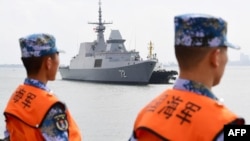A Chinese missile frigate returned last week from a five-day, friendly visit to the Philippines -- days after a Chinese fleet had visited Cambodia and half a year after a Chinese state firm started taking bids to build a nuclear-powered aircraft carrier, a sign of Beijing’s growing power at sea.
Multiple media outlets last week cited a Chinese Xinhua News Agency report saying the People’s Liberation Army ground forces had dwindled to less than half China’s total 2.26 million troops as the number at sea grew.
This mounting evidence of Chinese naval expansion will show first in the South China Sea, experts say, upsetting five other governments that dispute Beijing’s maritime sovereignty claims, and challenging U.S. defense for the weaker states.
“I think it’s not a battle that anyone can hope to win against China except the United States, and even then at very high cost, so the issue is about trying to make clear that (China is) not intimidated from maintaining their existing claims,” said Euan Graham, international security director with the Lowy Institute for International Policy.
Strongest forces in Asia
Naval scholars in the West had forecast 10 years ago that a high-seas navy would become a key to China’s military modernization.
As of 2012, the Chinese navy had 512 ships, according to the British think tank International Institute of Strategic Studies. It now has 714 ships, the database Globalfirepower.com says. China also operated more than 710 naval aircraft in 2012, according to the British research and news organization Flightglobal Insight. The ArmedForces.eu website says is has 780 aircraft now.
Two years ago, Chinese President Xi Jinping signaled he was trying to bring the army under a central command to improve its coordination with the navy.
Any battlefront would more likely be at sea than on land, Graham said, and naval hardware normally reaches the South China Sea before anywhere else.
“The pattern for new equipment tends to be that they go to the South sea fleet first, so we could expect it’ll just be a continuation of the same trend where the fruits of naval modernization are concentrated in the South China Sea,” he said.
Pressure on Southeast Asia
Brunei, Malaysia, the Philippines, Taiwan and Vietnam contest all or some of China’s claims to about 90 percent of the fishery-rich, oil-laden South China Sea spanning 3.5 million square kilometers.
But they are all militarily weaker than China and might find it harder under a stronger Chinese navy to access small island outposts or prime fishing spots, maritime scholars say. China already lets its own fishing boats mass in disputed waters as a deterrent to other countries, Graham said.
“There’s not much they can do about this in the surrounding countries,” said Oh Ei Sun, senior fellow with the Singapore Institute of International Affairs. “We may just privately worry about it.”
China has alarmed the other claimants since 2010 by landfilling a series of tiny islets, some for military use.
China and the Southeast Asian countries are negotiating now a code of conduct to prevent mishaps, but the code, due in 2021, is expected to avoid anti-China language.
U.S. and outside powers
China worries most about the naval activities of outside powers, especially the United States, Japan and Australia. Those countries lack sovereignty claims to the sea but don’t want China to control it.
The U.S. Navy regularly sends ships to tell China that Washington considers the sea to be open for international use. Over the past half-decade, the United States and its allies have offered Southeast Asian countries military training as well as intelligence about China’s activities.
The U.S. Navy most recently sent a guided-missile destroyer January 7 to the sea’s Chinese-controlled Paracel Islands, which are contested by Taiwan and Vietnam.
“To me, the real target of the deterrents is really the United States and the other middle powers, like Japan, Australia and India,” said Sun Yun, East Asia Program senior associate at the Washington D.C.-based Stimson Center think tank. “Looking at the coastal line along the West Pacific, South China Sea is the only area where the U.S. and China are engaged in confrontational postures.”
Armed confrontation in the South China Sea between Beijing and one or more Southeast Asian states ranks as a “top tier” U.S. priority because of the sea’s volume of commercial shipping and the U.S. legal obligation to defend the Philippines as needed, the Council on Foreign Relations think tank says.
What happens in Sino-foreign maritime relations eventually comes down to numbers of new ships and personnel actually deployed in the sea, Oh said.
“An increase in the naval personnel has to be accompanied by an increase in equipment and various other military postures,” he said. “If they are building 10 more frigates and so on, maybe people will be surprised.”







